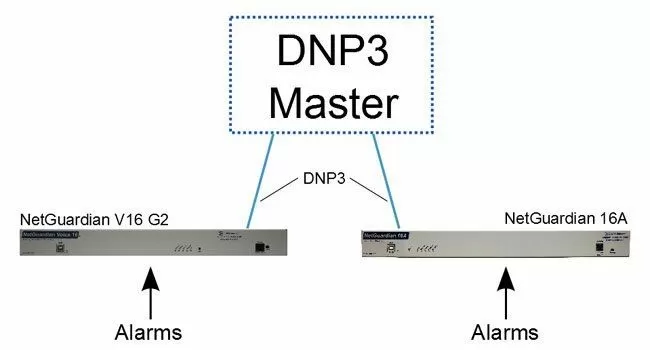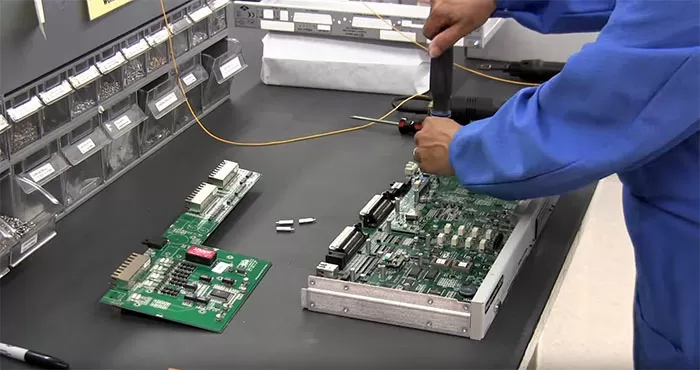Check out our White Paper Series!
A complete library of helpful advice and survival guides for every aspect of system monitoring and control.
1-800-693-0351
Have a specific question? Ask our team of expert engineers and get a specific answer!
Sign up for the next DPS Factory Training!

Whether you're new to our equipment or you've used it for years, DPS factory training is the best way to get more from your monitoring.
Reserve Your Seat TodayThe DNP3 - short for Distributed Network Protocol - is one of the widely used within the electrical and water utility industries for monitoring equipment over serial or IP.
The DNP3 protocol is actually a set of communications protocols that are used for communications between SCADA (Site Control and Data Acquisition) systems components. This protocol was developed to provide for communication between SCADA system devices and Intelligent Electronic Devices (IED's).
In order to efficiently protect your important communications, you need to gain visibility of your network by deploying a network alarm monitoring system that follows DNP3 best practices.
Let's take a look at what these best practices are.
The first best practice we're going to cover involves having DNP3 RTUs that you can truly rely on.

A DNP3 RTU is any remote terminal unit that can report alarms in the DNP3 communications protocol. A DNP3 RTU's role in the SCADA system is to collect alarms from individual devices used by the SCADA operation. They forward these alarms to a DNP3 master, which notifies technicians of the communication problems reported by the DNP3 RTUs.
Your DNP3 RTUS are an important part of your SCADA monitoring system. When purchasing a DNP3 RTU, it's important to look for the most advanced features for your network. You'll also want to look at the needs of your individual sites, and decide which DNP3 features will be most important to your mission-critical operations.
Another point to keep in mind is that, when deploying a SCADA monitoring system, you'll need to find a DNP3 RTU that can provide the capacity you need for all of your alarm points while leaving room for your SCADA system to grow. Your system can grow easily when your DNP3 RTU provides you with expansion options. You can expand your point capacity or add external temperature sensors.
If you need to monitor values - such as battery levels, temperature, humidity, and more - find a DNP3 RTU that provides for analog alarm monitoring in addition to monitoring your discrete alarms. With analog alarm monitoring, your remote can report alarms detailing these values to your DNP3 master.
Advanced DNP3 RTUs allow you to define thresholds for these alarms. They will alert you when one of these values has crossed a major or minor threshold above or below optimal conditions.
Also, with features such as expansion options and analog alarm monitoring, your DNP3 RTU will provide you visibility of your SCADA operation.
A good example of a competent RTU is the NetGuardian 832A. This powerful NetGuardian can support a variety of protocols and network architectures with advanced monitoring functions.

Also, if this your case, this remote can help you make a cost-effective transition to a more advanced monitoring equipment. By replacing your older DNP3 remotes with the advanced NetGuardian 832A, you can continue to transmit data from your network devices to your existing master while enhancing your monitoring with these advanced applications. Gradual migration using the NetGuardian makes it easy to upgrade to modern remotes over several budget cycles, allowing you to modernize your network without exceeding your annual budget.
A DNP3 master provides you with visibility to your DNP3 protocol devices. Deploying a DNP3 master will maximize your network uptime by displaying a notification any time there is a problem with your mission-critical SCADA operations.
A DNP3 master is one of the most important components of a SCADA monitoring system. Working with an advanced DNP3 master will help you to make the most of your DNP3 remotes' capabilities.

The DNP3 master interacts with your DNP3 RTUs to collect alarms from across your network. Advanced masters also receive alarms of all your other protocols. The DNP3 master takes these alarms, logically organizes them, and informs your network techs of issues that might need some kind of response. This will bring your network back online quickly; minimizing lost revenues while your network is down.
The most advanced masters will forward these alarms directly to your network technicians through pager, email, or cell phone. They will also display alarms in a single, convenient browser window. This allows your network operator easily view all standing alarms. You can even group alarms by user-defined criteria, such as severity, location, and etc.
These notifications provide up-to-the-minute visibility of your equipment network. This increases your network uptime and reduces customer churn. With alarm monitoring information immediately available to your monitoring and field techs, you should experience faster problem resolution and service restoration.
The third best practice we'll cover is finding a perfect-fit remote monitoring solution for your unique scenario.
When seeking out DNP3 equipment, it's important to find a unit that will give you the most functionality for your money. The right DNP3 gear for you will typically pay for itself several times over by preventing lost revenues from outages by maximizing your network uptime.
After all, when choosing your DNP3 SCADA equipment, shouldn't you only pay for the things you need?
Many monitoring and SCADA solutions come pre-packaged as a generic "one-size-fits-all" solution, but your network isn't like everyone else's. That's why perfect-fit and fully customizable engineering is such a valuable tool.

Instead of overspending on equipment to get all of the functionality you need, you should search for tailor-made devices that were designed to tackle your specific SCADA challenges.
In a nutshell, what can perfect-fit engineering do for you?
Spend less on equipment by having gear that gives you all of the features you need, without forcing you to pay for the ones you don't.
You'll know that a device is going to fit right into your network.
You'll probably get guaranteed results, especially if your vendor offers you many-back guarantees.
Using DNP3 in a contemporary SCADA system is an easy decision.
DNP3 is a standard protocol that has wide acceptance in the industry and is flexible enough for almost any application. DNP3 certainly has its place in an effective monitoring solution, but - as you know - this doesn't mean that any off-the-shelf DNP3 master or remote will be a best fit for you.
Before you commit to an SCADA monitoring solution for either your operating center or your remote sites, you need to consider a multitude of factors.
So, make sure to check for these eight important features:
Masters should provide concise alarm information
Masters sometimes present data in such an attractive, graphical interface that you get too involved in the details of a problem to look at the situation as a whole.
Make sure that you have access to a list view that provides a good presentation of event and alarm detail for more than a single site or region. Sometimes, summary graphical presentation can make detail an inconvenient click or two away when a decision needs to be made.
Masters should be able to identify cleared alarms
If you will be relying on unsolicited messages in your system, make sure there is a clear event for each alarm. Creating this association can involve expensive custom development on your master system.
Masters also should maintain a history of standing alarms
Avoid the allure of maintaining only an event log of newly reported unsolicited messages and a history log of acknowledged unsolicited messages. If an unsolicited message represents an alarm condition, there should be continuing visibility to the alarm even if the unsolicited message is acknowledged.
Imagine what might happen to your network if a system operator acknowledges an alarm message, and then, for whatever reason, fails to correct the alarm condition. Who would know the alarm is still standing?
Your remotes should support redundant power
If your remote is powered from a single source, then your critical monitoring is vulnerable to a single event. Losing that single source of power effectively compromises the continuous monitoring of your revenue-generating equipment.
If your installation doesn't have dual power sources, then make sure your equipment is compatible with an external uninterruptable power supply. Also, ensure that the primary power is one of the points monitored at each location.
Remotes should provide local SCADA
If a network failure compromises the collection of data, your remote equipment should provide for local visibility. Turn the worst case scenario of having to dispatch techs to critical remote sites into a much better case by ensuring that they'll be able to browse to your remote units and have local SCADA until the network is up and running again.
Masters should sort and filter alarms
The best masters support organizing alarms by a wide variety of characteristics. Location, equipment type and severity are just a few possibilities that may make sense for organizing your alarms.
The same alarm should be able to be posted to multiple categories. The presentation of sorted and filtered alarms should depend on the user logged on; the team responsible for generator maintenance doesn't need to wade through lists looking for generator events and alarms.
Masters should support flexible and powerful notification
Also, make sure your master support the advanced features necessary for premium status monitoring, such as notification escalation, nuisance alarm silencing, automatic control relay operation, and automatic notifications by email, text or pager.
Get a master that is not limited to DNP3
If your company is like most companies, you have a variety of equipment of different ages and technologies. Integrating the diversity into a SCADA master can sometimes involve surprisingly expensive customization or additional modules.
It can be difficult and uncomfortable to justify significant development costs after purchasing an already expensive SCADA master. So, why take time, trouble, and expense to recreate capabilities that are already present in a high-quality, multi-protocol master that is DNP3-capable?
Before you make a decision about your SCADA DNP3 monitoring project, there's a lot more you need to know. Making informed decisions will allow you to avoid dangers, while also taking opportunities to improve your remote site maintenance.
So, when choosing a network monitoring vendor, don't take chances. Be skeptical, ask the hard questions.
But, above all, look for experience. Don't take a sales rep's word that his company can do custom development. Ask how many systems they've worked with, how many protocols they can integrate with DNP3, and check for client testimonials.
We've created hundreds of successful monitoring implementations for telecoms, utilities, and transportation companies. Our solutions are proven performers under real-world conditions.
Also, we provide SCADA monitoring solutions backed by a 30-day, no-risk, and money-back guarantee. Test your DPS solution at your site for 30 days. And, if for any reason, you're dissatisfied, just send back for a full refund.
The bottom line is that you're never taking any risks when you work with us.

Morgana Siggins
Morgana Siggins is a marketing writer, content creator, and documentation specialist at DPS Telecom. She has created over 200 blog articles and videos sharing her years of experience in the remote monitoring industry.